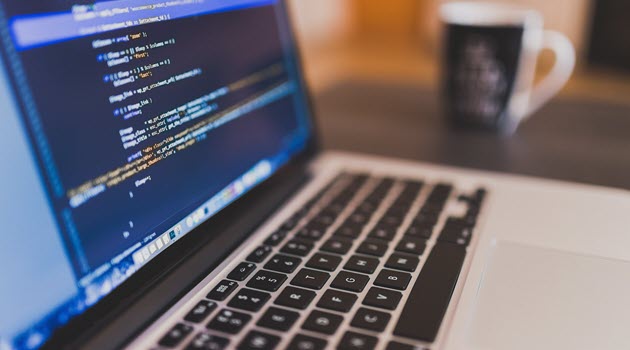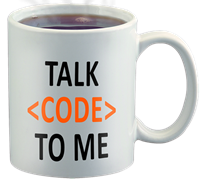How to Learn to Code Fast – 5 Simple Steps

Coding is absolutely one of the best ways to get into a career in IT. If you want to know how to learn to code fast, the steps in this post us exactly what you need.
Coding is a skill that is always in demand. Apart from being lucrative, another great thing about coding is that it has various niches within it. This means you can choose to focus on an area that actually excites you.
Please wait before you click off this post because you think coding is hard. Let me tell you, coding can actually be quite simple. You’re probably thinking, it’s easy for me to say considering my Computer Science background.
But I kid you not, YOU can learn how to code (fast even) with the steps below.
Do you have an analytical mindset? Do you like to think methodologically through tasks? If you do, then coding might be right up your alley.
First, let’s briefly discuss 3 reasons why you may want to learn to code (fast or slow).
- Money, money, money – You can go ahead and sing the song ?
There are simply a lot of opportunities for high paying jobs in the coding world. Many of those jobs can also be remote, which is a double plus. Whatever your current job is, you can switch over to a lucrative career in Information technology using coding skills. The need is there, why not help fill the need?
- Career Independence
You may be looking for work independence and the ability to work on your own terms. When you learn to code, you can choose to freelance. When you freelance, you can select your own clients and projects and work the hours that you want.
You can even have coding as a side gig to supplement your primary job. Many people do this to supplement their income. Whichever route you choose with coding, you have the potential to do well.
- Increased interpersonal and communication skills
You may be working on a computer as a coder, but you still need to work with people. In fact, if you’re looking to advance your career, you need some essential soft skills. When you learn how to code and start working with people, you will learn many interpersonal skills. As you work on projects for clients, you will learn how to interact and become a better communicator. Having excellent interpersonal and communication skills set you up for career success.
Now that you have a few reasons to learn to code, let us review the 5 simple steps on how to learn to code fast. Sure, ‘fast’ is relative and depends on the way you implement the steps. But if you don’t get stuck trying to make a decision, you might surprise yourself on how quickly you learn.

Step 1: Understand Your Goal
The first step in the process is that you need to find your reason for coding. Why do you want to learn to code (and learn fast)? What career goals are you trying to achieve?
Identifying the reason why you want to learn to code is important. This is because the reason you identify is your motivation. Your motivation is what will keep you going when you get tired.
You need to identify and harness the power of that motivation throughout the learning process.
Every time you feel like giving up, think of your reason for learning to code. Think about the new job you can get. Think about how the higher salary can command with the new skills. What will that mean for your financial freedom?
I have started some courses in the past that I just could not finish. Why was that? I did not have any motivation to complete those courses.
On the other hand, there are some courses that I finished learning within a few days? Why did I complete those courses quickly? I was super motivated because I truly wanted to learn the information in the course.
So, find your ‘why’ for learning to code and keep that reason close by anytime you need some motivation to keep learning.
Step 2: Select Your Coding Interest Area
Now that you have your motivation ready to go, what is next? You have to identify your specific coding interest.
Coding is a broad field that requires different skills depending on the coding area. So, you have to identify which particular area of coding you would like to pursue. This is a crucial step to learn how to code fast. If you don’t do this, you will delay the process by going around in circles.
Here is a summary of the main areas of coding. A post that goes into more detail for each of these areas will be published soon.
Web Development
Web development is focused on building websites for different purposes. This could be websites for informational purposes or websites that require user interaction. This is an excellent niche to start to learn how to code because it is in great demand and has a lot of flexibility. It is also probably a little easier than application development.
Application/Software Development
Application/Software development is focused on building applications and software that people utilize to complete different tasks. Think of mobile applications or even applications you use in your organization.
Application/software development can vary in that some applications/software are built from scratch using programming languages. In contrast, other applications/software are pre-built by other companies (proprietary software) and just need configuration for organizations that want to use them. Many companies are always looking to hire application developers and this could be a great area for you if interested.
Front End Development
Front End development is simply the part of coding that works on the interface users see. Think of the way you see and interact with websites online. The part you are seeing on your computer is designed by front end developers.
Programming languages for front end development include HTML, CSS, and JavaScript
Back End Development
Back end development is the part of coding that is behind the scenes. While users do not see this part on their web browsers, it is doing a lot of the work that ends up being seen on the computer or browser.
Programming languages for back end development include Java, PHP, Python, and Ruby
As you can see, there are many options for coding areas. You can actually learn more than one of the areas, but I don’t recommend starting with more than one. Master one area first, then you can start adding on other areas to become a coding guru.
Don’t get caught up in making this decision. If you get stuck in analysis paralysis, then you are wasting time deciding instead of learning.
Here’s the great thing about making a decision. You can always change your mind if you don’t like the area you initially selected. No knowledge is lost, so what you’ve already learned can be applied to the new area you select.

Step 3: Select a Programming Language
Motivation. Check.
Coding Area. Check.
What’s next?
Now, you have to identify the programming language you want to learn for the coding area you selected.
First, what is a programming language? Simply put, a programming language is the code that is used to communicate with the computer.
Think of it like the language that you speak, like English. When you speak English to another person that understands English, you can communicate easily. However, if you are speaking English to someone that does not understand English, you need to first translate the words.
So, a programming language is the way we translate what we want the computer to do from human language into a language the computer understands.
There are many different programming languages. Each programing language has its own code that tells the computer to do different things in different ways. This is why it’s so important to identify which aspect of coding you want to pursue first. That decision narrows down the available set of programming languages that you can choose to learn.
Here is a list of the popular programming languages.
- C Family: C, C#, C++
- CSS
- HTML
- Java
- JavaScript
- Kubernetes
- Perl
- PHP
- Python
- Ruby
- SQL
- Swift
Based on your selection for the coding area you want to pursue, do some research to identify the associated programming languages. I have some listed in point 2 above. Then you select one to start learning.
Again, please don’t get stuck analyzing this decision. If you want to learn how to code fast, you need to move quickly. Even if you do not want to learn how to code fast, you do not want to get paralyzed by indecision. Time wasted because of indecision can be spent actually learning something.
I recommend starting with only one language so that you can focus your efforts. If you don’t like the programming language you initially selected, you can always select another one. Make sure you give each one your best shot though. You don’t want to waste valuable time cycling through the languages instead of mastering one.
If you want additional information, Mikke of Mikke Goes has an excellent overview of 14 programming languages that you can check out. Laurence over at Learn to Code with Me also has a great podcast and article on deciding which programming language to learn.
Step 4: Select a Course and Start Learning
Once you’ve selected the programming language, you’re ready to start learning!
You have to identify courses for your selected programming language to begin learning. This seems simple enough, but this is where I have seen most people get stuck.
Why?
There are tons of courses out there teaching the various programming languages and it can get overwhelming to pick one.
My recommendation here is for you to use a quick decision method.Remember, we are trying to avoid analysis paralysis and the time that it wastes.
Identify 2-3 places to learn how to code and just start. Try to look for courses that have lots of opportunities for you to practice and create sample projects.
In this post, I share a list of 15 places to start learning to code online for FREE. This is a great place to start your research as a new coder. While these sites are free, they offer a lot of great courses on many of the languages listed above.
If you have given one programming language your best and still don’t like it, then simply switch. An added bonus of using the list of free courses is that you can switch to another course without cost implications.
When you start to learn how to code, you need to learn with a plan. My tip to learn how to code fast is to practice a lot using these 3 steps.
- Focus on understanding the programming language and syntax as you go through the course.
- When practicing, try to write the pseudocode first and then translate to programming code. Pseudocode is simply writing the code in English so that it makes sense to you. When I started coding, this translation step helped me link the programming language syntax to the action I wanted the computer to complete.
- Now, translate the pseudocode to real code based on the syntax knowledge. This should be relatively easy now that you have a clear picture of what you’re trying to achieve.
You will probably only need to follow these 3 steps for a short time when you begin to learn how to code. Once you’ve completed a few projects, you will be thinking in programming languages and may not need the pseudocode translation.
5. Create a Portfolio
Congratulations! If you’ve taken a course, you should have written your first (maybe 10th) piece of code and maybe even completed a project.
You’re not done yet though. You need to practice, practice, practice.
Now that you know the basics of a programming language. You need to make sure you master it as much as possible. This can only be achieved by continually learning and practicing what you have learned.
I also recommend creating a portfolio of projects that you complete. You can save your portfolio on GitHub for free. This is a great way to remind yourself of what you have achieved as a coder. It will also help you with your resume when you start looking for jobs.
When looking for coding jobs, it is vital to have a portfolio showcasing your prior work. This will help the interviewer assess your skill level. If you have a great portfolio, it increases your chances of getting the job.

That is all! 5 simple steps for you to learn to code fast.
These steps cut through the clutter that you see on the internet and help you learn to code fast. The key is making decisions quickly and moving on to the next step. Also, once you start taking courses, you want to give it your best effort. I have seen people learn a significant amount of new coding skills in a matter of weeks.
Are you a coder? Are you looking to become a coder? Which of these steps did you find helpful? Let me know what you think and if you have any questions below.
You can also check out these other posts.
2 thoughts on “How to Learn to Code Fast – 5 Simple Steps”
Comments are closed.
I always want to learn coding and looking for quality resources all the time.
thank you very much for putting together this awesome guide!
Thanks Hari. Glad you found the post useful.